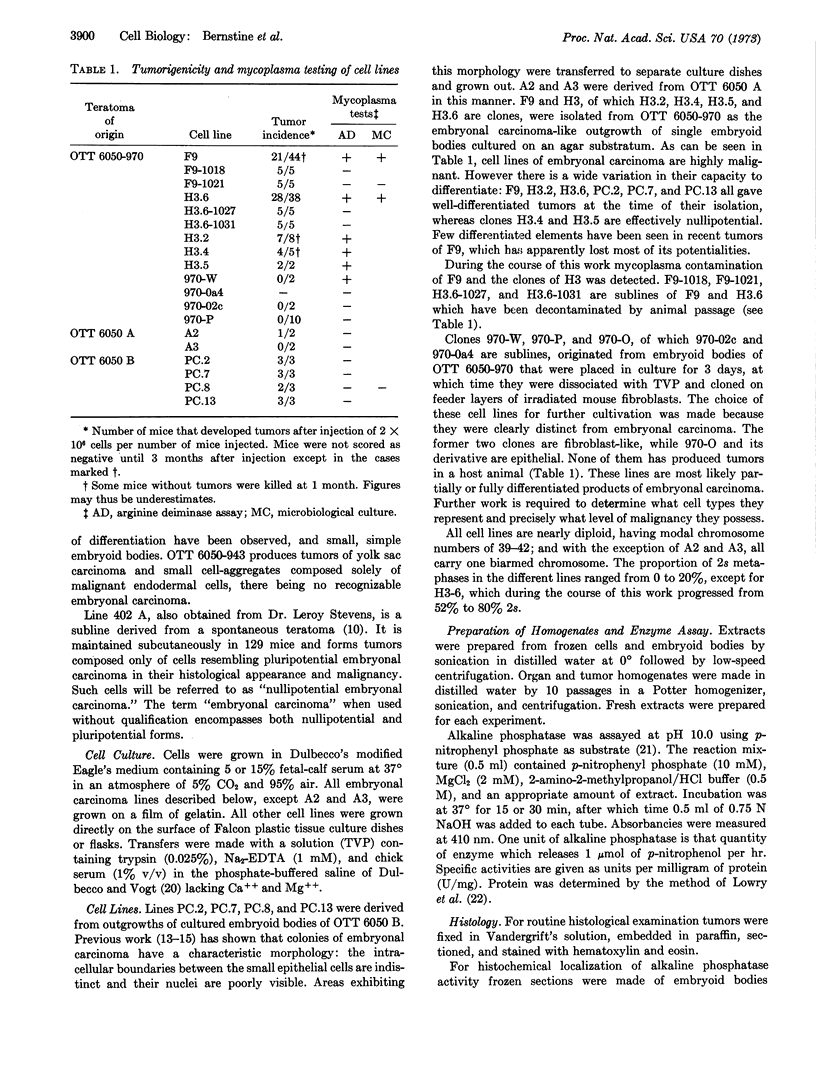Abstract
In tumors and embryoid bodies of mouse teratoma a correlation has been established between specific activity of alkaline phosphatase (EC 3.1.3.1) and content of embryonal carcinoma, the stem cell of the tumor. A histochemical study of embryoid bodies has shown that high levels of the enzyme are confined to embryonal carcinoma. Fifteen tissue culture lines could be classified into three groups: (a) lines identifiable as pluripotential embryonal carcinoma by their morphology, tumorigenicity, and capacity to differentiate in vivo; (b) nullipotential embryonal carcinoma, resembling pluripotential embryonal carcinoma in morphology and malignancy but giving rise to undifferentiated tumors; and (c) lines of apparently nonmalignant somatic cells. Both types of embryonal carcinoma possess levels of alkaline phosphatase 5- to a 100-fold higher than the somatic cell lines. The embryonal carcinoma enzyme resembles the enzymes from kidney and placenta in kinetics of thermal inactivation and sensitivity to the inhibitor L-phenylalanine, but is distinguishable from the alkaline phosphatases of liver and intestine. These findings are discussed in relation to the use of teratoma for the study of cell differentiation.
Keywords: cell differentiation, tumors, embryoid bodies, tissue culture, histochemistry
Full text
PDF




Images in this article
Selected References
These references are in PubMed. This may not be the complete list of references from this article.
- DULBECCO R., VOGT M. Plaque formation and isolation of pure lines with poliomyelitis viruses. J Exp Med. 1954 Feb;99(2):167–182. doi: 10.1084/jem.99.2.167. [DOI] [PMC free article] [PubMed] [Google Scholar]
- Dunn G. R., Stevens L. C. Determination of sex of teratomas derived from early mouse embryos. J Natl Cancer Inst. 1970 Jan;44(1):99–105. [PubMed] [Google Scholar]
- Eaton R. H., Moss D. W. Inhibition of the orthophosphatase and pyrophosphatase activities of human alkaline-phosphatase preparations. Biochem J. 1967 Mar;102(3):917–921. doi: 10.1042/bj1020917. [DOI] [PMC free article] [PubMed] [Google Scholar]
- Evans M. J. The isolation and properties of a clonal tissue culture strain of pluripotent mouse teratoma cells. J Embryol Exp Morphol. 1972 Aug;28(1):163–176. [PubMed] [Google Scholar]
- FISHMAN W. H., GREEN S., INGLIS N. I. Organ-specific behavior exhibited by rat intestine and liver alkaline phosphatase. Biochim Biophys Acta. 1962 Aug 13;62:363–375. doi: 10.1016/0006-3002(62)90266-4. [DOI] [PubMed] [Google Scholar]
- Finch B. W., Ephrussi B. RETENTION OF MULTIPLE DEVELOPMENTAL POTENTIALITIES BY CELLS OF A MOUSE TESTICULAR TERATOCARCINOMA DURING PROLONGED CULTURE in vitro AND THEIR EXTINCTION UPON HYBRIDIZATION WITH CELLS OF PERMANENT LINES. Proc Natl Acad Sci U S A. 1967 Mar;57(3):615–621. doi: 10.1073/pnas.57.3.615. [DOI] [PMC free article] [PubMed] [Google Scholar]
- Jami J., Failly C., Ritz E. Lack of expression of differentiation in mouse teratoma-fibroblast somatic cell hybrids. Exp Cell Res. 1973 Jan;76(1):191–199. doi: 10.1016/0014-4827(73)90435-7. [DOI] [PubMed] [Google Scholar]
- KLEINSMITH L. J., PIERCE G. B., Jr MULTIPOTENTIALITY OF SINGLE EMBRYONAL CARCINOMA CELLS. Cancer Res. 1964 Oct;24:1544–1551. [PubMed] [Google Scholar]
- Kahan B. W., Ephrussi B. Developmental potentialities of clonal in vitro cultures of mouse testicular teratoma. J Natl Cancer Inst. 1970 May;44(5):1015–1036. [PubMed] [Google Scholar]
- LOWRY O. H., ROBERTS N. R., WU M. L., HIXON W. S., CRAWFORD E. J. The quantitative histochemistry of brain. II. Enzyme measurements. J Biol Chem. 1954 Mar;207(1):19–37. [PubMed] [Google Scholar]
- LOWRY O. H., ROSEBROUGH N. J., FARR A. L., RANDALL R. J. Protein measurement with the Folin phenol reagent. J Biol Chem. 1951 Nov;193(1):265–275. [PubMed] [Google Scholar]
- MINTZ B. Continuity of the female germ cell line from embryo to adult. Arch Anat Microsc Morphol Exp. 1959 Dec;48(Suppl):155–172. [PubMed] [Google Scholar]
- PIERCE G. B., DIXON F. J., Jr Testicular teratomas. I. Demonstration of teratogenesis by metamorphosis of multipotential cells. Cancer. 1959 May-Jun;12(3):573–583. doi: 10.1002/1097-0142(195905/06)12:3<573::aid-cncr2820120316>3.0.co;2-m. [DOI] [PubMed] [Google Scholar]
- PIERCE G. B., Jr, BEALS T. F. THE ULTRASTRUCTURE OF PRIMORDIAL GERMINAL CELLS OF THE FETAL TESTES AND OF EMBRYONAL CARCINOMA CELLS OF MICE. Cancer Res. 1964 Oct;24:1553–1567. [PubMed] [Google Scholar]
- PIERCE G. B., Jr, DIXON F. J., Jr, VERNEY E. L. Teratocarcinogenic and tissue-forming potentials of the cell types comprising neoplastic embryoid bodies. Lab Invest. 1960 Nov-Dec;9:583–602. [PubMed] [Google Scholar]
- Rosenthal M. D., Wishnow R. M., Sato G. H. In vitro growth and differetiation of clonal populations of multipotential mouse clls derived from a transplantable testicular teratocarcinoma. J Natl Cancer Inst. 1970 May;44(5):1001–1014. [PubMed] [Google Scholar]
- STEVENS L. C. Studies on transplantable testicular teratomas of strain 129 mice. J Natl Cancer Inst. 1958 Jun;20(6):1257–1275. doi: 10.1093/jnci/20.6.1257. [DOI] [PubMed] [Google Scholar]
- STEVENS L. C. Testicular teratomas in fetal mice. J Natl Cancer Inst. 1962 Feb;28:247–267. [PubMed] [Google Scholar]
- Stevens L. C., Little C. C. Spontaneous Testicular Teratomas in an Inbred Strain of Mice. Proc Natl Acad Sci U S A. 1954 Nov;40(11):1080–1087. doi: 10.1073/pnas.40.11.1080. [DOI] [PMC free article] [PubMed] [Google Scholar]
- Stevens L. C. Origin of testicular teratomas from primordial germ cells in mice. J Natl Cancer Inst. 1967 Apr;38(4):549–552. [PubMed] [Google Scholar]
- Stevens L. C. The biology of teratomas. Adv Morphog. 1967;6:1–31. doi: 10.1016/b978-1-4831-9953-5.50005-6. [DOI] [PubMed] [Google Scholar]
- Stevens L. C. The development of transplantable teratocarcinomas from intratesticular grafts of pre- and postimplantation mouse embryos. Dev Biol. 1970 Mar;21(3):364–382. doi: 10.1016/0012-1606(70)90130-2. [DOI] [PubMed] [Google Scholar]




